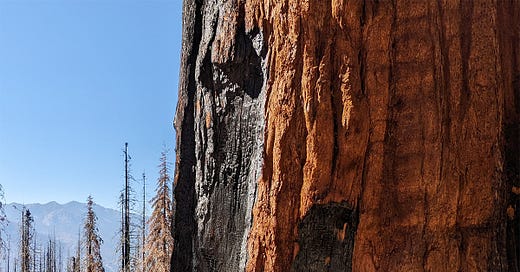For Halloween: Ghost trees and spooky spiders
Sadly, two giant sequoia ghost trees are now skeletons
Volume 1, Number 13 - Monday, Oct. 31, 2022
Orange and black in the forest — the bright trunk of a giant sequoia monarch with blackened conifer skeletons and orange (dead) foliage in the background. Black Mountain Giant Sequoia Grove, August 2022. — Claudia Elliott
Perspective
WHAT’S ORANGE AND BLACK and a little spooky?
Well, it could be the burned trunk of a giant sequoia I’ve shared with you here, with the blackened skeletons and dead orange foliage of hundreds of conifers in the background. Or the pumpkin you might have on your front porch, waiting for trick-or-treaters this Halloween night.
But, truth be told, walking through an ancient forest — burned or not — can be a little spooky at any time of year.
So it’s no surprise that there are trees called ghosts among giant sequoias — although the latest reports on two of them is that they were at least badly damaged if not killed in recent wildfires.
One giant sequoia called the “Ghost Tree” was among the largest trees in the Packsaddle Grove. According to the website, Famous Redwoods, the tree also was once known as the Gen. Robert E. Lee Tree — not to be confused with a tree that used to be called by the same name in Sequoia National Park (but no more, read here).
There is a map and many wonderful photos on the Famous Redwoods web page for Packsaddle Grove’s Ghost Tree. Alas, the grove was hit hard by the 2021 Windy Fire.
Sue Cag, who publishes a very informative website called I Love Trees and also has visited many groves after the wildfires of recent years shared information (and photos) about the fate of the Packsaddle Grove and its Ghost Tree here.
“The Ghost Tree was also hit (by the Windy Fire),” Cag wrote. “The trunk broke in half and appears hollow when seen from the top. Its lifeless side leader still hangs on and bits of green foliage cling to skinny low branches.”
Another giant sequoia was called the “Sierra Ghost” and grew in the Freeman Creek Grove. Richard and Kathy Ide, who publish an excellent website called Sequoia Quest and have been visiting and photographing giant sequoia groves since 2016, feature the “Sierra Ghost” here, with photos before and after the Castle Fire of 2020.
Here’s part of what they wrote: “This Sierra Ghost Tree was featured in a story told to us by a local old guy who affirmed that it was large enough to have corralled a dozen horses with just a rope wrapped around it. It is 25.5 feet in diameter level at the high side ground and 260 feet tall, and it stands on a couple-feet-high duff pile.” (The duff and more burned away in the 2020 wildfire.)
But ghost trees and blackened skeleton trees aren’t the only spooky things you might find in the southern Sierra Nevada.
San Diego State University biologists have identified a new lampshade spider species that lives there, too. You can read about these spiders here.
“Hypochilus are kind of like the Bigfoot of the spider world,” the SDSU professor says in the article. “They’re really special and from an older time.”
Like the towering sequoias, Hypochilus spiders are what is called paleoendemic, the article relates, meaning they were previously widespread in a region but are now more geographically restricted.
And — very cool, I think — The new spider species, Hypochilus xomote, is named for the Yowlumni word for south because the spiders are the southernmost known Hypochilus populations found in the Sierra — on the western side of the Sequoia National Forest, about 80 miles northeast of Bakersfield, on lands historically occupied by the Tule River Yokuts people.
Did you know you can comment here?
It’s easy to comment on items in this newsletter. Just scroll down and you’ll find a comment box. You’re invited to join the conversation!
Giant sequoias in the news
• The Calaveras Enterprise reports that a series of prescribed burns are underway this fall at Calaveras Big Trees State Park.
• Here’s a CalFire news release about the planned Calaveras burning.
• Ecologist and author George Wuerthner visited Yosemite National Park recently and wrote this piece critical of the forest management work there.
• The Smokey Wire published Jon Haber’s Public Lands Litigation Update including information about the Sept. 21 decision from District Judge Anthony W. Ishii who ruled against Earth Island Institute in a case that stemmed from Yosemite National Park’s plans for tree removal, called logging by some and biomass removal and thinning by the NPS.
• A giant sequoia art installation at the Oregon State University in Corvallis is intended to get people thinking about climate change and how people are adapting.
Giant sequoias around the world
The National Arboretum Canberra, Australia, has about 600 acres planted with more than 33,000 rare and endangered trees, including giant sequoias. Here’s a great video that shows that plenty of space was left between the trees when they were planted.
Want more?
GIANTSEQUOIANEWS.COM is also a website where you can find more information about giant sequoia trees, wildfire, the public land management conundrum and more.
Thanks for reading!




